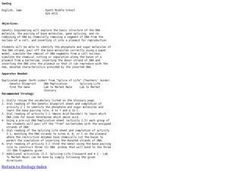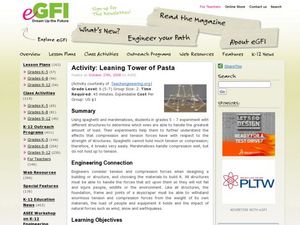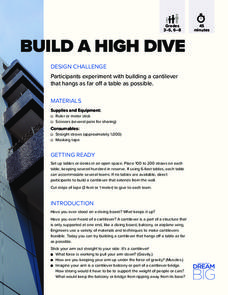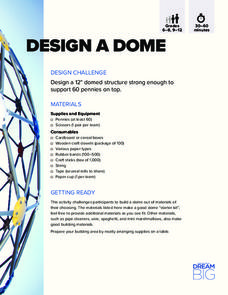Teach Engineering
Introduction to Water Chemistry
What are the issues surrounding water quality? Viewers of this short presentation gain information about the importance of clean water, the lack of fresh water, water contamination, and ways that engineers treat water.
Institute of Electrical and Electronics Engineers
Sticky Engineering Challenge
Students explore the properties of different adhesives. In this physics lesson plan, students construct a building structure and determine what glue to use in the process. They present their design in class.
Curated OER
Aerospace Engineering
Students explore oil field applications of Shape Memory Alloys. In this engineering activity students divide into groups and research mini research applications then complete a project.
Curated OER
Genetic Engineering
Students examine the advantages and disadvantages of genetic engineering. In this genetics lesson students simulate the genetic engineering of a human insulin gene.
Curated OER
Engineering For The 3 Little Pigs
Students engage in a instructional activity which demonstrates the importance of rocks, soils and minerals in engineering and how using the right material for the right job is important. The students build three different sand castles...
Curated OER
TE Activity: Environmental Interactions
Students design a web that shows the interactions between the living and non-living parts of the environment. They determine what an environment is and how engineers work together to solve problems. They complete a tally chart that they...
Curated OER
GenEng
Students investigate the process of genetic engineering. In this genetic engineering lesson plan, students use paper models of DNA and plasmid bacterium to investigate the process of replicating DNA, splicing genes from DNA, and...
Curated OER
Standard 4 Review Sheet-Genetics and Inheritance
In this genetics worksheet, young scholars answer a variety of questions about inheritance, DNA, the genetic code, genes, sexual and asexual reproduction, mutations, protein synthesis and genetic engineering.
Teach Engineering
Inside the DNA
Get your class to take a closer look at DNA. Pupils conduct research to determine the methods used by scientists to analyze the molecular structure of DNA. The class members investigate different types of molecular imaging along with gel...
Teach Engineering
Skeletal System Overview
It is best to know all about the skeletons in the closet. The third segment in a five-part series focuses on bone structure, development and growth, and functions. Class members connect what they learn to their study of...
Teach Engineering
Mechanics of Elastic Solids
Make the connection between Hooke's law and elasticity with an activity that introduces the class to the behavior of elastic materials. The resource defines stress and strain to calculate the modules of elasticity of...
Tech Museum of Innovation
Seed Dispersal
Engineering challenges are not just man-made ... nature has its own set of them. A hands-on STEM activity has groups designing a seed dispersal system. Each group can only use one sheet of paper — a tough task!
Teach Engineering
Edible Algae Models
Sometimes it's okay to eat your science experiment. A hands-on activity has pupils create models for algae to learn about its cellular structure. The best part of the experiment? The resulting juice-filled gels are edible—yum!
DiscoverE
A Leg to Stand On
Give your learners a leg up in their study of engineering. Groups design and create a prothestic for a leg. They test out their designs for strength, stability, durability, and comfort.
Teach Engineering
Skin and the Effects of Ultraviolet Radiation
Though UV radiation can damage skin, it isn't all bad. The third installment in a six-part series allows the class to study the structure and function of skin. They learn about the different types of skin cancer and the SPF rating...
Teach Engineering
Fun with Air-Powered Pneumatics
How high did the ball go? Engineering teams build a working pneumatic system that launches a ball into the air. The teams vary the amount of pressure and determine the accompanying height of the ball. An extension of building a device to...
Teach Engineering
Design Inspired by Nature
Let nature guide your engineering designs. By taking apart a flower, pupils learn about reverse engineering. They use the results to brainstorm designs for new products or ideas. This is the seventh installment of a nine-part Life...
Teach Engineering
Chair Design
Can you design the perfect chair? Scholars apply the engineering design process to design and build a prototype of a new type of chair from wires. They test their designs with a wooden artist model or stuffed animal.
Intel
Designer Genes: One Size Fits All?
In this STEM group of 10 activities, lesson two focuses on the question, "Just because we can, should we?" when considering genetically engineered food. Classes hear a scenario and, as young scientists and geneticists, must determine if...
Curated OER
Activity: Leaning Tower of Pasta
A well-laid-out lesson plan, this can be used in an engineering, STEM, or physical science course. Laboratory groups design a structure using pasta and marshmallows, measure its height and weight, and then discover the load that it can...
DiscoverE
Extreme Trampolines
You'll bounce off the walls with glee after finding a fun resource. Young engineers design trampolines for golf balls. They build and test out their design and make improvements based on the results.
DiscoverE
Build a High Dive
Can't build a cantilever? You'll be able to after a hands-on, constructive activity. Young engineers build cantilevers out of straws and tape. The finished products must be able to hang off a table as far as possible.
DiscoverE
Design a Dome
Do domed structures have advantages over their less-than-spherical counterparts? Junior architects explore the pros and cons of domes through a design challenge. Teams work together to plan, sketch, build, and test domes created from an...
DiscoverE
My Friend Robot
Can you do better than a robot? Teams write instructions for a hypothetical robot to build a structure. They test their instructions by acting them out to see if they produce the desired structure.

























